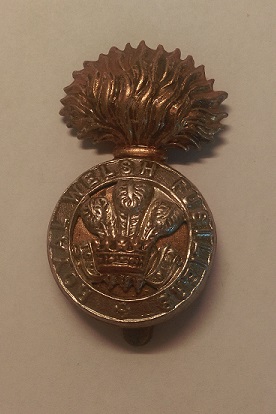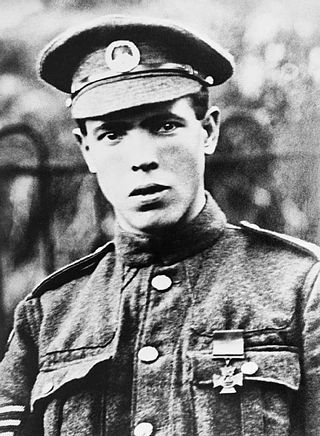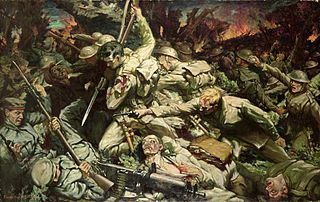
Hedd Wyn was a Welsh-language poet who was killed on the first day of the Battle of Passchendaele during World War I. He was posthumously awarded the bard's chair at the 1917 National Eisteddfod. Evans, who had been awarded several chairs for his poetry, was inspired to take the bardic name Hedd Wyn from the way sunlight penetrated the mist in the Meirionnydd valleys.

The Royal Welch Fusiliers (Welsh: Ffiwsilwyr Brenhinol Cymreig) was a line infantry regiment of the British Army, and part of the Prince of Wales's Division, that was founded in 1689; shortly after the Glorious Revolution. In 1702, it was designated a fusilier regiment and became the Welch Regiment of Fusiliers; the prefix "Royal" was added in 1713, then confirmed in 1714 when George I named it the Prince of Wales's Own Royal Regiment of Welsh Fusiliers. In 1751, after reforms that standardised the naming and numbering of regiments, it became the 23rd Regiment of Foot (Royal Welsh Fuzileers). In 1881, the final title of the regiment was adopted.

160th (Welsh) Brigade or Brigâd 160 (Cymru), is a regional brigade of the British Army that has been in existence since 1908, and saw service during both the First and the Second World Wars, as part of the 53rd (Welsh) Infantry Division. It is a regional command responsible for all of Wales. The Brigade is also regionally aligned with the Eastern European and Central Asian regions as part of defence engagement.

The 38th (Welsh) Division of the British Army was active during both the First and Second World Wars. In 1914, the division was raised as the 43rd Division of Herbert Kitchener's New Army, and was originally intended to form part of a 50,000-strong Welsh Army Corps that had been championed by David Lloyd George; the assignment of Welsh recruits to other formations meant that this concept was never realised.

Trawsfynydd is a linear village in Gwynedd, Wales, near Llyn Trawsfynydd reservoir, and adjacent to the A470 north of Bronaber and Dolgellau and 10 km south of Blaenau Ffestiniog. It also neighbours the towns of Porthmadog and Bala.

Company Sergeant Major Ivor Rees VC was a Welsh recipient of the Victoria Cross, the highest and most prestigious award for gallantry in the face of the enemy that can be awarded to members of the British and Commonwealth forces.

The Battle of Albert is the British name for the first two weeks of British–French offensive operations of the Battle of the Somme. The Allied preparatory artillery bombardment commenced on 24 June and the British–French infantry attacked on 1 July, on the south bank from Foucaucourt to the Somme and from the Somme north to Gommecourt, 2 mi (3.2 km) beyond Serre. The French Sixth Army and the right wing of the British Fourth Army inflicted a considerable defeat on the German 2nd Army but from near the Albert–Bapaume road to Gommecourt, the British attack was a disaster, where most of the c. 57,000 British casualties of the day were incurred. Against the wishes of General Joseph Joffre, General Sir Douglas Haig abandoned the offensive north of the road to reinforce the success in the south, where the British–French forces pressed forward through several intermediate lines closer to the German second position.

Frongoch is a village located in Gwynedd, Wales. It lies close to the market town of Bala, on the A4212 road.
Alan Llwyd, original name Alan Lloyd Roberts, also known under the Bardic name Meilir Emrys Owen, is a Welsh poet, literary critic and editor. He is one of the most prolific Welsh-language poets of the late 20th and early 21st centuries, and has won the bardic Chair at the National Eisteddfod three times and the Crown twice.
The Mametz Wood Memorial commemorates an engagement of the 38th (Welsh) Division of the British Army during the First Battle of the Somme in France in 1916.
This article is about the particular significance of the year 1916 to Wales and its people.

Hedd Wyn is a 1992 Welsh anti-war biopic, written by Alan Llwyd and directed by Paul Turner.

The 115th Brigade was an infantry brigade formation of the British Army raised during both the First and Second World War.
The 119th Brigade, originally the Welsh Bantam Brigade, was an infantry brigade formation of the British Army during World War I. Part of Lord Kitchener's 'New Armies', it served in the 40th Division on the Western Front. The brigade number was reactivated for deception purposes during World War II.

The Capture of Mametz took place on 1 July 1916, when the British Fourth Army attacked the German 2nd Army on the Western Front, during the first day of the Battle of the Somme. Mametz is a village on the D 64 road, about 20 mi (32 km) north-east of Amiens and 4 mi (6.4 km) east of Albert. Fricourt lies to the west, Contalmaison is to the north, Montauban to the north-east and Carnoy and Maricourt are to the south-east. Mametz Wood is 1,000 yd (910 m) to the north-west and before 1914, the village was the fifth largest in the area, with about 120 houses and had a station on the line from Albert to Péronne. During the Battle of Albert the II Bavarian Corps attacked westwards north of the Somme but was fought to a standstill east of Mametz. Reinforced by the XIV Reserve Corps the Germans on the north side of the Somme attacked again and took Mametz on 29 September. After a mutually costly battle for Fricourt, where the French were eventually forced out, the front line stabilised and both sides began to improvise defences. In mid-December a French local attack in the Mametz area was a costly failure.

The Welsh National Memorial Park is a war memorial in Langemark near Ypres (Belgium) for soldiers of World War I, located near the Pilkem Ridge in the former Ypres Salient. It commemorates the service of men and women of Welsh origin, wherever they served during the Great War as part of the Allied Powers, as well as the non-Welsh soldiers serving in Welsh formations.

The Welsh at Mametz Wood by Christopher Williams portrays the 11 July 1916 Charge of the Welsh Division at Mametz Wood, part of the Somme offensive. Painted at the request of the Secretary of State for War, David Lloyd George. Williams visited the scene in November 1916 and later made studies from a soldier supplied for the purpose. The painting is in the collection of the National Museum of Wales, to whom it was presented by Sir Archibald Mitchelson in 1920.

The 2nd Gwent Battalion was a Welsh 'Pals battalion' formed as part of 'Kitchener's Army' during World War I. Raised by local initiative in Monmouthshire and Brecknockshire, it became the 11th (Service) Battalion of the local regiment, the South Wales Borderers. It served in 38th (Welsh) Division and led the division's costly attack on Mametz Wood during the Battle of the Somme. The battalion continued to serve on the Western Front, including the Third Battle of Ypres. It was disbanded early in 1918, but many of its personnel remained together for a few weeks in a composite battalion that saw action at the Battle of Estaires in April 1918.



















